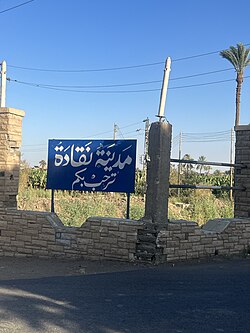
Back نقادة Arabic مدينة نقادة ARZ Накада Byelorussian Naqādah CEB Naqada (Stadt) German Naqada Spanish Naqada Basque نقاده Persian Nagada French Naqada (kota) ID
Naqada نقادة | |
|---|---|
 | |
| Coordinates: 25°54′N 32°43′E / 25.900°N 32.717°E | |
| Country | |
| Governorate | |
| Area | |
• Total | 35.94 sq mi (93.08 km2) |
| Population (2021)[1] | |
• Total | 188,984 |
| • Density | 5,300/sq mi (2,000/km2) |
| Time zone | UTC+2 (EST) |
| • Summer (DST) | UTC+3 |
| |||||
| nbyt[2][3] in hieroglyphs | |||||
|---|---|---|---|---|---|
| Era: Middle Kingdom (2055–1650 BC) | |||||

Naqada (Egyptian Arabic: نقادة Naqāda; Coptic language: ⲛⲉⲕⲁⲧⲏⲣⲓⲟⲛ Nekatērion;[4] Ancient Greek: Παμπανις Pampanis,[3] Ancient Egyptian: Nbyt) is a town on the west bank of the Nile in Qena Governorate, Egypt, situated ca. 20 km north of Luxor. It includes the villages of Tukh, Khatara, Danfiq, and Zawayda. According to the 1960 census, it is one of the most uninhabited areas and had only 3,000 inhabitants, mostly of Christian faith[5] who preserved elements of the Coptic language up until the 1930s.[6]
The ancient town contained a cemetery that held approximately 2,000 graves.[7] The first person to excavate the site was archaeologist Sir Flinders Petrie in 1894. Petrie was working for the Egypt Exploration Fund (now the Egypt Exploration Society) when he excavated the site. Some of the findings during the excavation included artifacts from the Amratian (Naqada I) and the Gerzeh (Naqada II).[8]
- ^ a b "Naqādah (Markaz, Egypt) - Population Statistics, Charts, Map and Location". citypopulation.de. Retrieved 17 March 2023.
- ^ Wallis Budge, E. A. (1920). An Egyptian hieroglyphic dictionary: with an index of English words, king list and geological list with indexes, list of hieroglyphic characters, coptic and semitic alphabets, etc. Vol. 2. John Murray. p. 1005.
- ^ a b Gauthier, Henri (1926). Dictionnaire des Noms Géographiques Contenus dans les Textes Hiéroglyphiques. Vol. 3. p. 84.
- ^ Ishak, Emile Maher (1975). The Phonetics and Phonology of the Boḥairic Dialect of Coptic and the Survival of Coptic Words in the Colloquial and Classical Arabic of Egypt and of Coptic Grammatical Constructions in Colloquial Egyptian Arabic. Vol. 1. University of Oxford. p. 164.
- ^ "Discrepancies between Coptic statistics" (PDF).
- ^ Worrell, W. H. (1937). "Popular traditions of the Coptic language". American Journal of Semitic Languages and Literatures. 54 (1/4): 1–11. doi:10.1086/370517. JSTOR 529250. S2CID 170527828.
- ^ Archaeology, Current World (2012-05-28). "Petrie at Naqada". World Archaeology. Retrieved 2024-03-17.
- ^ "Naqādah | Ancient City, Ruins, Archaeology | Britannica". www.britannica.com. Retrieved 2024-03-17.
